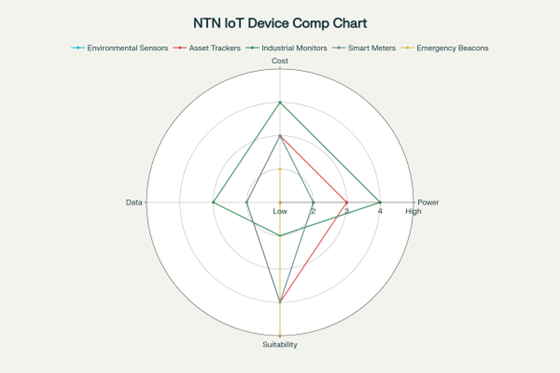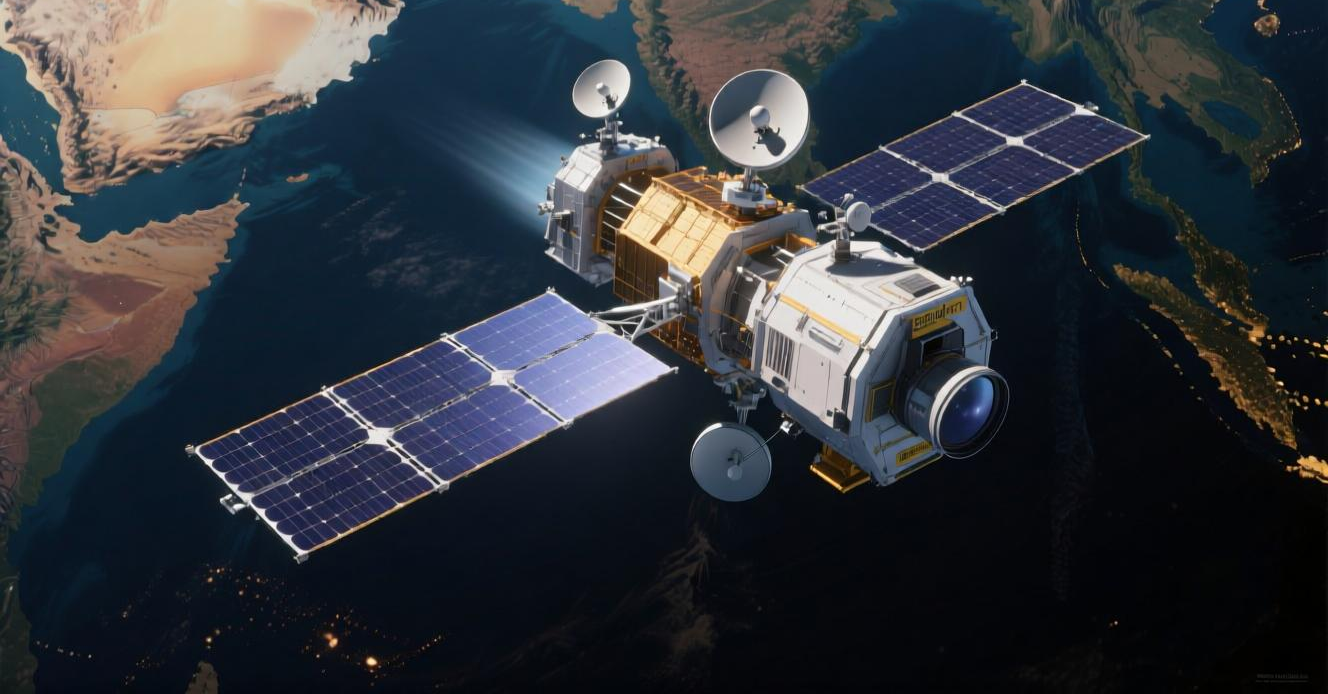Picture this: You’re tracking a shipping container somewhere in the middle of the Pacific Ocean, or monitoring oil pipelines in the middle of nowhere Alaska. Your fancy LTE Cat-M1 module? Useless as a chocolate teapot. Welcome to the reality where 90% of Earth’s surface has zero cellular coverage, and your IoT dreams hit the wall of geographical physics.[1]
This is where Non-Terrestrial Networks (NTN) swoop in like a technological superhero – though, spoiler alert, every superhero has their kryptonite.
What Exactly Are These Non-Terrestrial Networks?
Think of NTN as the marriage between your smartphone’s cellular brain and satellites floating around in space. Thanks to 3GPP Release 17 (yes, the same folks who gave us 5G), we now have standardized ways for your IoT devices to chat with satellites using the same protocols they’d use to talk to a cell tower.[2][3]
Instead of your data hopping from cell tower to cell tower, it takes a scenic route through space – bouncing off satellites orbiting at various heights, from Low Earth Orbit (LEO) at around 500-2000 km up, to Geostationary (GEO) satellites chilling at 35,786 km above Earth.[4]
The Sweet Spots Where NTN Actually Makes Sense
NTN isn’t trying to replace your urban cellular networks (that would be like using a sledgehammer to crack a nut). Instead, it shines in three specific scenarios:[5]
Mobile Assets in Coverage Voids: Your truckers driving through dessert or highland’s empty stretches. These devices normally use cellular but occasionally need that satellite backup when they’re in the middle of nowhere.[6]
Critical Infrastructure Backup: When a remote electrical substation’s primary connection goes down, or a natural disaster knocks out cellular towers, NTN provides that oh crap, we still need connectivity backup.[7][8]
Remote Sensor Networks: Environmental monitoring stations in forests, soil sensors on remote farms, or seismic monitoring equipment in areas where running fiber optic cables would cost more than buying a small country.[9][10]

Picture 1: Landmark of the current NTN implementation
The Reality Check: NTN’s Limitations (Let’s Be Honest Here)
Before you get too excited and start planning your NTN-powered smart toaster network, let’s talk about the not-so-fun parts:
Latency That’ll Make You Want to Pull Your Hair Out
While cellular networks deliver data in milliseconds, NTN operates on satellite time – anywhere from several seconds to tens of seconds for a round trip. GEO satellites? You’re looking at 280ms minimum, and that’s just the physics of radio waves traveling 71,000+ km round trip. LEO satellites are better at 100-200ms, but still nowhere near the sub-50ms you get with terrestrial networks.[11]
In fact, in this case the LTE Cat1bis make much more sense – read our post on this case: Why you should avoid the false dilemma on LTE Cat-M vs. NB_IoT
Power Consumption That Drains Batteries Like a Vampire
Your device needs to shout louder to reach a satellite than a nearby cell tower. We’re talking about 800mA transmit current versus 200-400mA for cellular – that’s roughly double the power consumption. Your 10-year battery life might become 5 years (if you’re lucky).[12]
Data Rates From the Stone Age
Forget about streaming Netflix to your IoT sensor. NTN NB-IoT typically operates at 1-2 kbps (compared to tens or hundreds of kbps for terrestrial NB-IoT), with message size limits of around 256 bytes. It’s perfect for sensor says temperature is 23°C but terrible for send me a firmware update.[13]
Costs That’ll Make Your CFO Cry
NTN modules cost significantly more than cellular equivalents – think $100-$1000+ versus $7-$100 for cellular IoT modules. Plus, airtime costs are many times higher than cellular data plans. It’s not exactly the budget-friendly option.[14][15]
Coverage Gaps (Yes, Even Satellites Have Limits)
Despite the global coverage marketing hype, current NTN NB-IoT coverage is limited to specific regions with spot beams over North America, Europe, parts of South America, and Australasia. It’s expanding, but we’re not at true global coverage yet.[16]
When NTN Makes Business Sense (And When It Doesn’t)
When NTN earns its keep:
Think about shipping vessels, cross‑border trucking fleets, mining operations, or scientific stations at the edge of civilization. In places where “no bars” isn’t a nuisance but a constant reality, NTN becomes more than a backup—it’s the only lifeline. It also makes sense for infrastructure you truly can’t afford to lose touch with, even if the main terrestrial link drops. And yes, if your system is only pushing small sensor readings every so often, the extra latency isn’t really a deal‑breaker.
When terrestrial still wins hands down:
On the flip side, if your devices are installed in cities or suburbs, or you need interactive, low‑latency communications (think vehicle‑to‑everything or emergency response), NTN is a poor fit right now. Applications that move a lot of data—streaming telemetry, frequent software updates—are also better left on conventional networks. And for high‑volume deployments measured in the tens of thousands, the economics simply don’t work out—terrestrial will almost always be cheaper and easier.
The Technical Reality of Implementation
Current commercial NTN modules like the Telit ME910G1-NTN or Quectel BG95-S5 are shipping and certified. Service providers like Skylo, floLIVE, and ORBCOMM offer actual working services – this isn’t vaporware anymore.[17]
But implementation comes with gotchas: your devices need clear sky visibility (no more hiding sensors in basements), antenna design becomes critical, and power management requires careful consideration of those higher current draws.[18]
The Bottom Line
NTN represents a genuine breakthrough in IoT connectivity – it’s the first standardized way to provide truly global device connectivity using familiar cellular protocols. But like any technology, it’s not a silver bullet.[19]
Upsides worth noting:
- The obvious one is reach: satellites finally close the gap where cellular networks don’t exist and probably never will.
- For industries with high uptime requirements, having a built‑in satellite fallback provides welcome resilience.
- Perhaps most underrated: 3GPP’s stamp of standardization. It means vendors and operators can finally align on a single way of doing things, instead of relying on proprietary satellite systems.
But the headaches stack up quickly, latency is still an immovable wall for real‑time use cases. Battery drain is another sleeper issue many deployments discover too late. And then there’s cost—not just the modules themselves but the airtime plans and the more demanding installation requirements. In short: the technology works, but it’s not turnkey, and it won’t fit every business case.
The smart approach? Start with a pilot program targeting your most critical remote applications where the higher costs are justified by the business value. Most successful deployments will likely be hybrid – using cellular where available and falling back to NTN in coverage gaps.
NTN isn’t going to replace terrestrial cellular networks, and frankly, it shouldn’t try to. But for those specific use cases where no connectivity isn’t an option, it’s finally moving from interesting idea to commercially viable reality.
Just don’t expect it to be cheap, fast, or simple. But hey, at least your container tracking will work in the middle of the ocean now.
The telco standards bring an ocean of opportunities (like LTE Cat1bis). On the other hand, some of the previous path of communication to IoT device are outdated – read a story about switching the 2G off: Save your products from 2G shutdown. IoT device manufacturers need to act now!
That’s true, at first glance it is hard not to feel lost. Good news I would like to share is that our domain experts are greedy to help you. Just contact us and we will help you to find best mobile solution for your fleet of devices.
If you’re interested in discussing available solutions for your IoT operations, feel free to reach out anytime.
Sources:
[1] https://www.gsma.com/solutions-and-impact/technologies/internet-of-things/wp-content/uploads/2024/08/Employing-Non-Terrestrial-Network-for-IoT-Connectivity.pdf
[2] https://www.3gpp.org/news-events/partner-news/ntn-rel17
[3] https://www.5gamericas.org/wp-content/uploads/2025/02/WP_New-Developments-and-Advances-in-5G-and-NTN-.pdf
[4] https://www.3gpp.org/technologies/deep-dive/ntn-overview
[5] https://www.gsma.com/solutions-and-impact/technologies/internet-of-things/wp-content/uploads/2024/08/Employing-Non-Terrestrial-Network-for-IoT-Connectivity.pdf
[6] https://www.gsma.com/solutions-and-impact/technologies/internet-of-things/wp-content/uploads/2024/08/Employing-Non-Terrestrial-Network-for-IoT-Connectivity.pdf
[7] https://www.3gpp.org/technologies/deep-dive/ntn-overview
[8] https://www.gsma.com/solutions-and-impact/technologies/internet-of-things/wp-content/uploads/2024/08/Employing-Non-Terrestrial-Network-for-IoT-Connectivity.pdf
[9] https://www.groundcontrol.com/blog/unlocking-ntn-nb-iot-with-nidd/
[10] https://www.gsma.com/solutions-and-impact/technologies/internet-of-things/wp-content/uploads/2024/08/Employing-Non-Terrestrial-Network-for-IoT-Connectivity.pdf
[11] https://www.groundcontrol.com/blog/unlocking-ntn-nb-iot-with-nidd/
[12] https://www.groundcontrol.com/blog/unlocking-ntn-nb-iot-with-nidd/
[13] https://www.groundcontrol.com/blog/unlocking-ntn-nb-iot-with-nidd/
[14] https://www.cavliwireless.com/blog/nerdiest-of-things/guide-to-cellular-iot-and-satellite-iot-connectivity
[15] https://www.groundcontrol.com/blog/unlocking-ntn-nb-iot-with-nidd/
[16] https://www.groundcontrol.com/blog/unlocking-ntn-nb-iot-with-nidd/
[17] https://www.groundcontrol.com/blog/unlocking-ntn-nb-iot-with-nidd/
[18] https://www.groundcontrol.com/blog/unlocking-ntn-nb-iot-with-nidd/
[19] https://www.3gpp.org/news-events/partner-news/ntn-rel17

